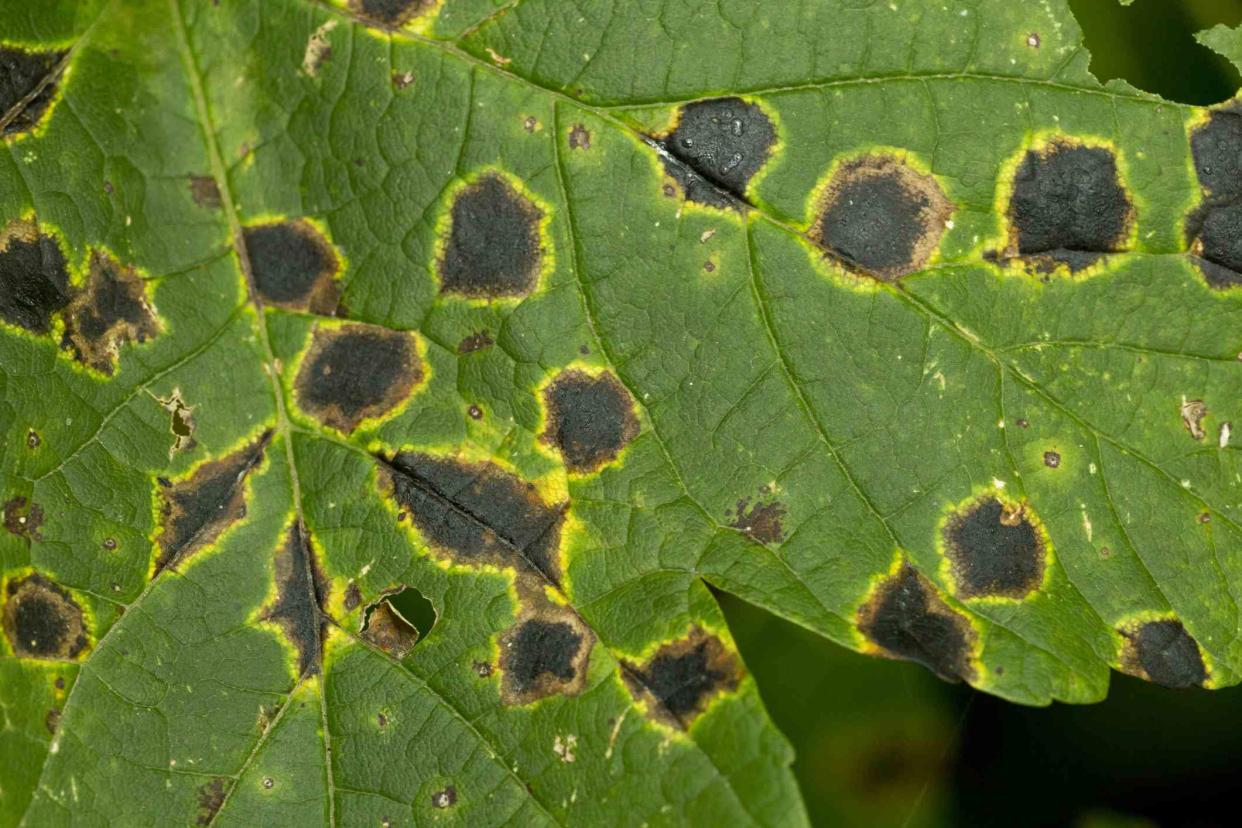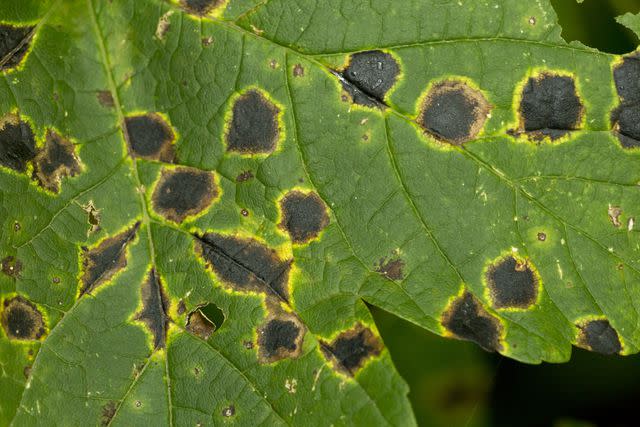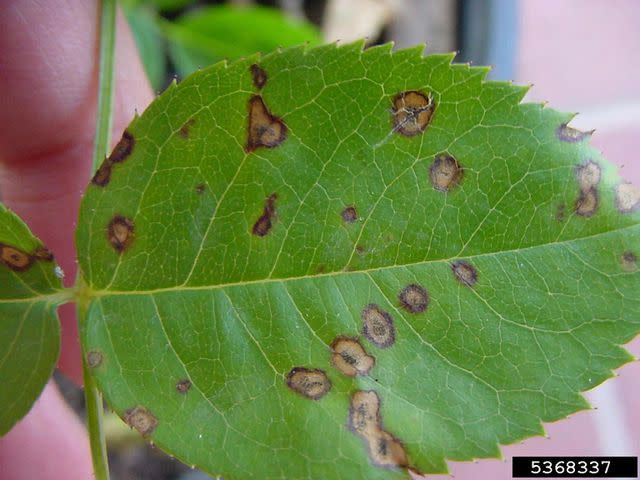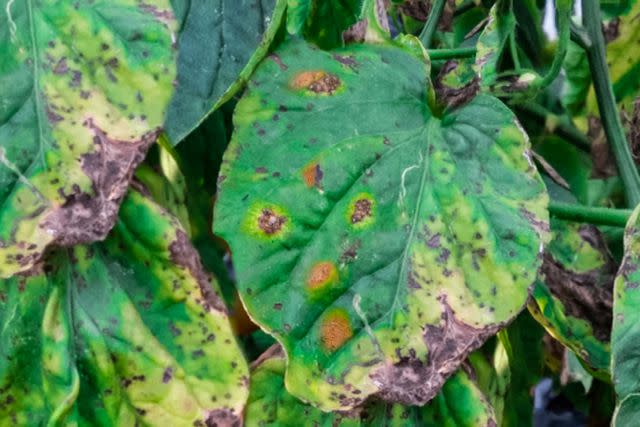Don't Let Leaf Spot Ruin Your Trees—Here's How to Treat It

Bob Gibbons / Getty Images
Leaf spot is a disease that attacks numerous edibles and ornamentals in the landscape, including perennials, shrubs, and trees. While it may temporarily spoil the appearance, it is usually not fatal. But if you're finding unsightly leaf spot and want to fight it, you can learn which plants are most susceptible to it and seek alternative specimens.
Below, we discuss the types of leaf spot diseases, how to tell if a plant has it, how you can identify leaf spot, and how to treat it.
The Basics of Leaf Spot
Leaf spot is a plant disease, but is rarely fatal.
You can avoid leaf spot either by taking preventive measures or by selecting plants less susceptible to it.
Since leaf spot is typically caused by moisture-loving fungi, spring is the worst season for this disease.
Types of Leaf Spot Diseases
Leaf spot can refer to any of a number of diseases affecting the leaves of plants. The pathogen causing the disease is typically one of the many kinds of fungi, but bacteria can also be the culprit.

Bob Gibbons/Getty Images
Pathogens that can be responsible include the following:
Septoria
Cercospora
Didymellina
Phyllosticta
Pseudomonas
Xanthomonas
How to Tell If a Tree Has Leaf Spot
True to its name, the presence of leaf spot is announced by rounded spots or blotches that suddenly appear on the foliage of a plant. In extreme cases, enough spotting may occur to kill the whole leaf.
In most cases, no permanent harm will come to the plant. In fact, on a large, established plant, you may not even notice a mild case of leaf spot.
Concern is, however, warranted when a small plant loses too many leaves to the disease. Watch for spotting on the leaves of newly installed plants so that you can treat the leaf spot on them before excessive foliage is lost.

Identifying Leaf Spot
Not every spot on a leaf is "leaf spot." Sometimes, damage caused by an insect will appear as a spot. Angular spots, meanwhile, can indicate the presence of anthracnose disease, which is another plant problem caused by fungi.
Nor will the spot on a leaf infected by leaf spot always look the same. Spots vary in size, shape, and color:
Size: Spots can be small or become so big that, eventually, they combine to cover a large swath of the leaf.
Shape: While the spots are rounded, their specific shape varies from circular to oblong. A spot can appear as a darker spot within a lighter ring.
Color: Spots can be brown, tan, gray, or black.
How to Treat Leaf Spot
While leaf spot is rarely fatal, you may want to avoid having the appearance of your favorite plant marred by this disease. The first step in controlling leaf spot is understanding where it comes from.
The fungi that cause leaf spot overwinter in fallen leaves that had been infected during the past growing season. Even if none of your own plants had leaf spot, infected leaves from other people's plants may have been blown onto your land by the wind.
During a rainy spring, the spores in these fungi may splash up onto the tender new leaves of your emerging plants. After germination, the leaves can become infected if they remain wet for a long period of time.

The Spruce / K. Dave
Proper Gardening Practices
Leaf spot is a disease that you must prevent: Once you see spotting on your foliage, there is nothing you can do to save that foliage. To prevent leaf spot, take these five measures:
Avoid overhead watering: Getting foliage wet unnecessarily is an invitation to fungi.
Avoid watering in the evening: Likewise, watering too late in the day gives foliage less time to dry out before night comes. If you water in the morning, your garden has all day to dry out.
Provide proper spacing between plants: This promotes good air circulation, which helps foliage to dry faster.
Remove infected leaves and dispose of them properly: This is an ongoing process throughout spring and summer. Whenever you see a leaf infected by leaf spot, remove it from the plant and treat it as trash (do not compost it).
Do a thorough job with fall clean-up in the garden: At the end of the growing season, rake your garden and landscape thoroughly. Pay particular attention to removing fallen leaves from the base of any plant that you know to be susceptible to leaf spot.
Plant Selection
Some plants are more susceptible than others to leaf spot disease. By avoiding growing these plants, you lessen the likelihood of having leaf spot disease on your property.
When researching new plants that you wish to grow on your property, take note of which ones are listed as being prone to leaf spots and seek alternatives to those plants.
Examples of plants susceptible to leaf spot include hosta (Hosta spp.), mountain laurel (Kalmia latifolia), and magnolia (Magnolia spp.)
Read Next: Identifying and Treating Leaf Spot Fungus on Magnolia Trees
Read the original article on The Spruce.

